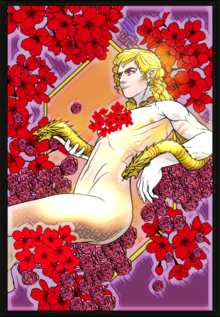| Estelley |
|---|
 |
| Religion |
|---|
| Pronunciation |
Estel-lei |
|---|
| Origins |
15,000 years ago. |
|---|
| Deities |
|---|
|
10 unified Gods. |
| Subsects |
|---|
|
Regional interpretation differences. |
Estelley is the ancient faith of air and light, a proud, judgmental Religion that demands the best of its worshipers so that the world might be redeemed and men suffer no longer. It is primarily the domain of the Elven Races and Cultures, though others convert if they believe that the Estelley Gods may give them grace and protect their people, or that its clear and defined virtues are easier to live by than those of their native religion. Estelley worshipers believe that they are opposed in their divine struggle both by those who teach alternative paths to paradise and those who seek to corrupt the world alike, but that Estel's truth and the truth of her prophets will emerge victorious, and that mortal heroes will see the Elves to a golden age where they want for nothing and no one.
Origins
Estelley is rooted in the history of the Elven Races, even though its followers do not all belong to that people. It is understood that early Elven history played host to a patchwork of bronze-working kingdoms in a strange world far unlike the modern one, murals depicting lanky and alien-looking long-eared mortals doing business with the Dewamenet, the similarly oversized, though muscular ancestors of the Asha, and a whole range of other cultures that have since been erased from Aloria. Each kingdom tended to favor a single patron god, the divinities bickering and fighting like the people did, until Estelley's first prophetess Talea swept through like a wildfire conquering throne after throne and uniting the Gods she went under the dogma of the over-deity Estel, a sleeping creation goddess who rests in the world beyond. Talea's divine right was proved at the tip of her spear and down the barrel of her spellcraft: uniting the Elves into the first iteration of Estelley dogma, recorded on a variety of stone slates and obelisks meticulously handed down. While Estelley is associated with Exist Magic and the powers of that Dimension due to Estel's lordship over it, they have a more complex understanding of their own Gods. While the Void and Ordial Gods had to sign bargains with other entities to escape their own Dimensions into Aloria's reality, the Estelley Gods were always native to the mortal plane and came into their arcane powers later, as a gift from Estel through Talea in a single mystery-shrouded event called "the Convergence". The Convergence is tied to the similarly murky Elven-Dewamenet War, which ended in that people's subjugation and enslavement: and so it is unlikely that a clear answer will ever be passed down about what the Convergence was or what it entailed, even from the lips of the Gods themselves.
Since Talea there have been two more prophets, no less important than she. Second was her younger brother Sanraan, who after the destruction of the Dewamenet cursed the Allorn victory as a defeat and proclaimed that an Empire built on poison would not last, and third was her youngest brother Fenhellëy who wrote the codes of governance and proper rule, also beginning the tradition of favoring Leyon as Estelley's highest god that would eventually become dominant outside the Allorn Empire. There have been no major modifications to Estelley dogma since the time of Fenhellëy, a boon and a curse at once. For while Estelley worshipers can claim with confidence that they have the most unedited and accurate religion to the exact practice of their forefathers, their faith's inability to change has often led to its defeat in its struggle against the usurping religions that have challenged it throughout history. Despite this, Estelley is still one of the world's most popular religions practiced by a large range of cultures, and has a presence in most major states.
Core Beliefs
Estelley preaches that the world was created inherently flawed, and that it is the Estelley Gods who shall lead the people closer to perfection so that Estel might, when the last sinner disappears from Aloria, remake it in her divine image and merge the realms of the living and the dead. It does not deny the strength of divinities from other religions, such as Dragons or Unionist Divines or even its hated enemies the Void Gods, but believes that they were created to lead mortals astray. Each Estelley God has a different role to play in bringing about this perfect world, and while priests and written dogma are allowed to be incorrect, the Gods are considered infallible by way of their divinity. This has led to complicated situations where two opposed Estelley Gods have given contradictory instructions to the faithful, but with the overall understanding that different instructions can be valid at different times, and both still have their uses. While the religion is named after Estel, no actual worship of Estel is performed, focusing instead on the Pantheon of Gods who she empowered through Talea and relegating her to a purely creative role. It is understood that Estel is in a state of "slumber," with some believing that she is dead, and some believing that her consciousness is inactive until prophecy will require it to reawaken.
Divine Mechanics
All Religions provide 1 single Mechanic to their Believers that fits within the flair of their Religion. This Mechanic is lost if the individual stops believing in the Religion, or becomes a heretic, but can be regained. Afflicted can use this mechanic, but having the mechanic does not imply that they have blanket forgiveness from their Gods, just that there is more nuance to it than that.
- Estelley Faithful can manifest an "Avatar of the Gods", which is a Spirit who does not have a free will and is instead fully controlled by the person (and in a way, is a conduit of the person). This Avatar is themed and aesthetically built after the Patron God of the individual, does not reserve Kill-Perms (meaning anyone can kill it in Combat, but does re-manifest after 24 hours), and is not a Disguise. The Avatar can have their own Proficiency Points and Abilities, counting as a Spirit, (and if used, should be mentioned on a Character Application including the point spread, but is not their own person and does not have their personality that exists besides the Estelley worshiper (functioning like the Worshipper putting on VR goggles at their home and piloting the Avatar). Remember, Spirits, even ones from Gods, are still very illegal in the eyes of the Law!
Standards of Perfection
Estelley does not have a formal set of Vices and Virtues, but rather so-called Standards of Perfection. Standards of Perfection are general life-goals and ambitions the faithful should strive towards. Once they feel confident they have met the Standard, they seek out Estelley Priests and undergo the Trials of Preparation, where the priests trial their perfection, sending them back to learning if they fail, and giving them a blessing and official recognition to their Ascendance. Estelley Faithful as such go through life seeking Ascendances, with most faithful having completed several Ascendances by the time they reach advanced age.
- Leyon's Standard of Perfection is both having the strength and endurance to protect one's self, but also to protect others around one's self, even for no benefit to self.
- Artarel's Standard of Perfection is to act with perfect clarity, to judge the actions of others without succumbing to attachment, and do what is right, not what feels good.
- Melca's Standard of Perfection is foresight to understand the troubles of the age, and to be well-informed and properly prepared for all eventualities that might arise.
- Sapphora's Standard of Perfection is cleverness to make oneself likeable, to be inoffensive without being incapable, to be welcomed anywhere and a pleasure to any stranger.
- Avinla's Standard of Perfection is to stoke the fire of life, to create and love and enjoy, to bring new things into the world and rekindle joy in those who have lost it.
- Ammuloa's Standard of Perfection is to regard death without fear, to throw oneself into battle without becoming addicted to it, and to kill with respect and dignity, always.
- Sinnavei's Standard of Perfection is valor to brave the deepest wilds and cunning to escape them alive, good investment in a good cause, and honesty to rely on one's allies.
- Vyrë's Standard of Perfection is redemption to turn dark skill to a good cause, to do little kindnesses from the shadows, to never forget the rejected and unloved.
- Aseia's Standard of Perfection is erudition to understand the world, to record its many happenings and people, to never forget a moment, but never get caught up in the past.
- Mana's Standard of Perfection is kindness to reach in love to others, to steward the little creatures of nature, to tend to gardens and to have hands that heal and soothe.
- Cemaan's Standard of Perfection is having the skill and wit to conquer and subjugate others, to win at trial of arms, and bend the weak to one's will as a ruler of men.
Exist Arken
Arken are powerful beings of Magic who each embody a single idea, some created from Exist Magic, some from Void Magic. Many religions name them Demons and enemies, such as Draconism and Unionism, while others raise particular Arken to Godhood, such as Fornoss which favors the Void Arken. Estelley does neither. Rather, it casts particular Exist Arken as heralds to their Gods, given the divine charge to protect their worshipers where they are unable to and enforce their power in the world. In the Allorn period there were seas of hundreds of named and known Arken strong enough to serve this role, with individual Estelley deities maintaining whole hosts of Arken allies, but in the modern day the death or absorption of many Arken as well as Justice's divine ascension has led to only three powerful enough remaining: Compassion who serves Mana as a Maquixtl named Ixchel, Rejection who serves Vyrë as a Maraya named Ammalla, and Beauty who serves Sapphora as a Fin'ullen named Vernaela. Unlike the Estelley Gods, Arken are not considered infallible. Even if they are Heralds, their orders can be disregarded completely without committing blasphemy or sacrilege, though others may still take offense.
Merjan
The Estelley afterlife is a very real and tangible thing. Called Merjan, a place-name as if it were just another principality or place that one could charter a carriage to, it is reached at the end of one's life by a ferry taken down the "straight river" by the death god Ammuloa. On one's way down the straight river, they relive their life over and over and over again as a series of disjointed flashes of moments or important events, given the opportunity to reflect on past ills done to others or suffered done to the self. Especially important is the moment of death: Estelley worshipers are very afraid of dying in bad circumstances or alone or of disease, because it might haunt them for decades as they journey to the afterlife. Past a series of gates guarded by Leyon, the souls of the Estelley dead dwell in Merjan's fair halls and await paradise to be achieved in the world of the living so that it might be united with theirs in perpetuity. This situation is moreover complicated by the Lanlath race, who dwell in a series of pocket dimensions under the protection of Leyon. Many theorize and understand that since Leyon controls both the gates to the afterlife and built the pocket dimensions the Lanlath live inside, that the Lanlath in fact live in the outer layers of Estelley heaven and serve as a sort of security buffer between the mortal world and the souls of the dead, with the "straight river" to Merjan that Ammuloa sails existing somewhere in one of the more secret Lanlath realms that even they themselves have not been able to devise.
Gods and Goddesses
Estelley recognizes that all Gods are real and all Gods are infallible, but that when gods disagree one is always worth more than the other. What this complicated idea means can be explained through the example of Cemaan. All Estelley worshipers except Allorn ones generally spit on and reject Cemaan, but they don't reject the idea that she is a divinity or that she somehow has a point. Rather, they believe that her instructions are a way to solve the problem ("Estelley worship must be preserved,") but not the right way to solve the problem, and prefer to follow Leyon's dogma which usually opposes hers. All the same, this does not mean that she is not a God, and even when ignored is treated with a certain fearful deference. It is traditional to see Leyon as the father god and the strongest in the Estelley Pantheon, a view held by all except the Allorn Elves, who hold onto Talea's original assertion that Cemaan is the head of the pantheon.
Leyon, Lord of the Full Moon
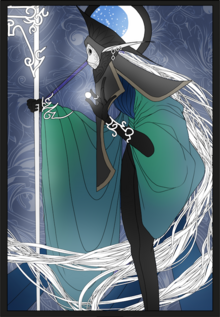
- Name: Leyon, Lord of the Full Moon, Keeper of the Destiny Gates.
- Domain: Leyon's domain is benevolence, protection, Radiant Magic, and civilization.
- Symbols: Leyon's symbols are metal marbles, keys, doorways, and especially the moon.
- Role: Leyon watches the door to the afterlife and dispenses wisdom to lost mortals.
- Traits: Mute, Thoughtful, Wise, Pensive, Haunting, Dignified, Royal.
- Temple: Leyon's largest Temple is the House of Lunar Eclipse in Silverspire.
- Allies: Regulus followers, Alexander followers, Bev & Dáuw followers, sages, scholars.
- Enemies: Caius & Ifrit followers, Power & Pride Arken(born) & followers, tyrants.
- Favor: Leyon is seen as a patron of the Lanlath and their Senleya Order.
- Rituals: Leyon rituals involve the composition of holy poetry and bardic song on the great heroes of the past, protection given to others, and the binding Rite of Hospitality where a wounded nemesis on a Leyon worshiper's doorstep accepts their protection, but becomes Magically unable to betray their host for the duration of their stay.
|
|
Artarel, Lord of Judgment
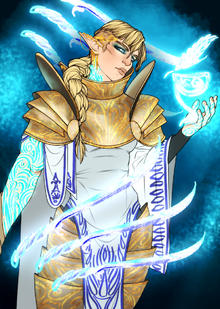
- Name: Artarel, called the Justice Arken by nonbelievers.
- Domain: Artarel's domain is fairness, judgment, restitution, and vengeance to evil.
- Symbols: Artarel's symbols are the Scales of Jawat, Justice Flames, and floating blades.
- Role: Artarel is the ultimate judge of the sin of the living and the dead.
- Traits: Haughty, Headstrong, Domineering, Idealistic, Vengeful, Bitter.
- Temple: Artarel does not yet have a Temple, as she is recently ascended.
- Allies: Bard followers, Odal followers, Elia followers, Khannar followers (it's complicated).
- Enemies: Pride Arken(born), Void Arken, Evolist followers, Khannar followers (it's complicated).
- Favor: Artarel favors anyone who takes up her mission to destroy all Sinners.
- Rituals: Traditional Estelley legal proceeds are an elaborate form of Artarel ritual, Estelley honor duels are sanctified in Artarel's name, the destruction of Sinners and stifling of arrogance also pleases her if done correctly. Artarel's zealot priests are the Inulvaan, who wear four-faced helms and suffer in search of holy wisdom.
|
|
Melca, Foreseeing One
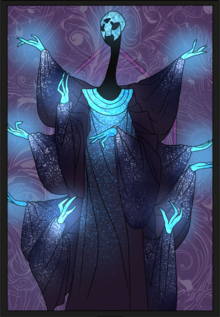
- Name: Melca, the Foreseeing One, Mother of Mysteries, who now aids the Sihndar.
- Domain: Melca's domain is foresight, danger, adversity, and the unknown.
- Symbols: Melca's symbols are glittering starry fabric and khopesh swords.
- Role: Melca whispers hushed warnings into others' ears to avert calamity.
- Traits: Anxious, Compassionate, Hurried, Detailed, Elaborate, Careful.
- Temple: Melca's largest Temple is the House of Warning in Alta Hold.
- Allies: Caan and Kaldric followers, Elkonur followers, Severena followers.
- Enemies: Gahan followers, Rand followers, Kathar, Suvial, Theurgists and Summoners.
- Favor: Melca is seen as a patron of the Sihndar and their holy Blue Sky Wardens.
- Rituals: Melca's worshipers invoke "pity them, Melca" before battle with any mortal, as they would rather turn their swords on Spirits only. Their Blue Sky Wardens, clad in ceremonial Melcarite armor (see her art), travel the world in search of new weapons for future calamities. The purest form of Melca Worship is banishing Void Spirits.
|
|
Sapphora, Heart's Desire
- Name: Sapphora, the Heart's Desire, Lady of Here and Now.
- Domain: Sapphora's domain is popularity, sociability, and extroversion.
- Symbols: Sapphora's symbols are snakes, silver fans, and wine goblets.
- Role: Sapphora holds salons in Amontaar, testing the wit of worshipers.
- Traits: Vain, Self-Obsessed, Gregarious, Lustful, Likeable, Witty.
- Temple: Sapphora's largest Temple is the Mesvaan Palace in Amontaar.
- Allies: Eikki followers, Vess followers, socialites, sapphics.
- Enemies: Wirtem people, the austere, those who break hospitality.
- Favor: Sapphora is seen as a patron of the Minoor island Elves.
- Rituals: Hosting parties in general is respectful to Sapphora, even if her name is not directly invoked. She is not a deity with extensive ritual or who demands observance through complex worship, though some fanatic loyalists do take the extra step of traveling to her temple to reproduce with her and have Sapphora Godborn.
|
|
Avinla, Divine Hearthkeeper
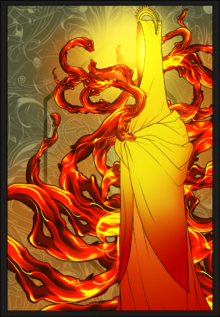
- Name: Avinla, the Divine Hearthkeeper, Tender of the Flame.
- Domain: Avinla's domain is the warmth of life, fire, passion, and craftsmanship.
- Symbols: Avinla's symbols are almost always only fire motifs in red and yellow.
- Role: Avinla petrified herself in sacrifice to save the Suvial from annihilation.
- Traits: Motherly, Wistful, Amicable, Insightful, Passionate, Giving.
- Temple: Avinla's largest Temple is Dhruvagni Niketa in Avela Travinda.
- Allies: Efrat followers, Leif followers, mothers and guardians.
- Enemies: Ordial Entities, Kathar, Evolist followers, murderers.
- Favor: Avinla is seen as a patron of the Suvial people.
- Rituals: Avinla's rituals often involve the holy fire. Whether tending one and stoking it for as long as possible, throwing alcohol into it to bless the departed in their name, or using a portion of it to kindle new fires, most of their rituals rely on it. In a figurative way, Avinla's rituals can also be about 'giving the fire to others,' the gift of life.
|
|
Ammuloa, Last Ferryman
 - Name: Ammuloa, the Last Ferryman, Death's Whisper.
- Domain: Ammuloa's domain is death and the dying, undeadism, and warfare.
- Symbols: Ammuloa has no symbols, depicting him is inviting death into one's home.
- Role: Ammuloa is the lord of the afterlife and the creator of Estelley Undead.
- Traits: Morose, Silent, Grimly Prophetic, Dutiful, Sincere.
- Temple: Ammuloa's largest Temple is Rammath's Mausoleum in Charossa.
- Allies: Daiana followers, Bev followers, grave-tenders and undertakers.
- Enemies: Ordial Entities and Spirit enslavers who would rob his Faithful of death.
- Favor: Ammuloa is seen as a patron of the Fin'ullen people and Deathwatch Undead.
- Rituals: Ammuloa's most famous ritual is his Rite, by which a living faithful is sacrificed and turned Undead with the sacred task to guard a name, a place, or a family until their destiny is fulfilled and they can rest. Ammuloa worshipers also practice reading scrolls of achievements of the famous slain, so that others know to live up to their example.
|
Sinnavei, Mistwatcher
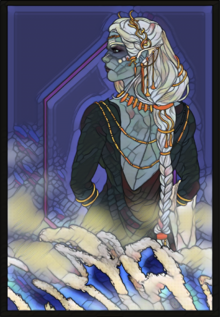
- Name: Sinnavei, Mistwatcher, our Lady of Valor.
- Domain: Sinnavei's domain is the wild, its beasts, and the resolve to face them.
- Symbols: Sinnavei's symbols are mist curl patterns and songbird motifs.
- Role: Sinnavei binds the Estelley faithful to Regalia, and to foresee calamity
- Traits: Insightful, Solitary, Generous, Private, Reflective, Well-Meaning.
- Temple: Sinnavei's largest Temple is the High Chair of Windwhere in Solleria.
- Allies: Guided Unionism followers, Theomar followers, Aelrrigan Knights.
- Enemies: Argentum Knights, Anarchists, Evolism followers, Regalia-Haters.
- Favor: Sinnavei is seen as a patron of the Solvaan and the Regalian Empire.
- Rituals: Sinnavei's liveliest ritual is the Great Hall Muster where soldiers give one another gifts of equipment and good blessings for the battles to come, but her worshipers also enjoy going on hunts together or simply enjoying the beauty of nature's creation whether by making landscape paintings or sitting together in quiet sacred groves.
|
|
Vyrë, Deep Empress
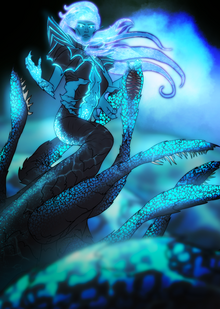
- Name: Vyrë, Deep Empress, Mother of the Dark, Shelter of the unloved.
- Domain: Vyrë's domain is the unwanted, pariahs, freaks who others reject.
- Symbols: Vyrë's symbols are wave designs, rough storms, and deep sea beasts.
- Role: While Talea acts as Empress on the land, Vyrë is the ruler of the seas.
- Traits: Wroth, Imperious, Rude, Self-Assured, Commanding, Charismatic.
- Temple: Vyrë's largest Temple is the Great Trench Table in Ïlha Faiaal.
- Allies: Void Mage & Void Arkenborn Estelley followers, Marken, the poor.
- Enemies: Draconism followers, justiciars, the wealthy, Purists.
- Favor: Vyrë is seen as a patron of the Daphalar, Magic Mer-Fin'ullen.
- Rituals: Vyrë rituals always have a violent or sacrificial element to please the Empress of the Deep. For example, the Whalesong Feast in Ilha Faial where tables of seafood long enough you cannot see one end from the other side are shared after a six-hour brawl, some more impressive years drawing Vyrë herself to attend. Feasts, brawls, all are popular in her name.
|
|
Aseia, Great Librarian
- Name: Aseia, Great Librarian, Left Half of the Great Lady.
- Domain: Aseia's domain is secrets, libraries, and enlightenment.
- Symbols: Aseia's symbols are books, tomes, and his Fountain of Knowing.
- Role: Aseia studies life in the hopes that he can create the perfect being.
- Traits: Inquisitive, Focused, Dedicated, Knowledgeable, Profound.
- Temple: Aseia's largest Temple is the Lessariaton Library in western Daen.
- Allies: Nox followers, Chantli Maquixtl, Qadir, Maraya, scholars.
- Enemies: Inth followers, any who destroy the records of history.
- Favor: Aseia is seen as a patron of Suel's cult of Chantli Maquixtl.
- Rituals: Aseia's rituals involve recording and cataloguing information. There are those who dedicate their whole life to acting as walking libraries to other Elves and those respected enough to be allowed to browse their mind for wisdom, sometimes also referred to as Ancestor Oracles, because their knowledge is so profound it approximates Magic.
|
|
Mana, Compassion's Hand

- Name: Mana, Compassion's Hand, Right Half of the Great Lady.
- Domain: Mana's domain is love, compassion, kindness, and nature's little creatures.
- Symbols: Mana's symbols are trees, laurel wreaths, thorns, and flower bundles.
- Role: Mana inspires mortal worshipers with reasons to live in happiness.
- Traits: Joyous, Kindly, Grandmotherly, World-Wise, Empathetic.
- Temple: Mana's Temple was destroyed by Kathar, her followers worship at Mana Trees.
- Allies: Xotik and Sentli Maquixtl, Yanar, farmers and the keepers of nature's bounty.
- Enemies: Mana feels for the pain of even the darkest Gods, and bears no ill will.
- Favor: Mana is seen as a patron of the Maquixtl and Yanar.
- Rituals: Mana's rituals inevitably center around agriculture. Harvest festivals are incredibly popular even among non-Estelley worshipers as a way to get some of the free food her priests hand out, various animal rearing competitions like dog shows and similar are popular as well. Worshipers also beseech her to ward off plague and famine.
|
|
Cemaan, Blue Empress
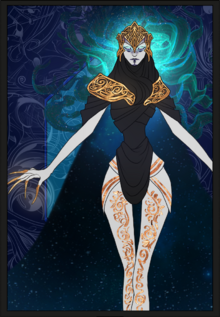
- Name: Cemaan, the Blue Empress, the Crusher of Nations.
- Domain: Cemaan's domain is war, conquest, slavery, and subjugation of others.
- Symbols: Cemaan's symbols are the Crown of Victory, scepters, glowing blue chains.
- Role: Cemaan intervenes in the mortal world to combat the Allorn Empire's enemies.
- Traits: Domineering, Vicious, Direct, Proud, Powerful, Sarcastic.
- Temple: Cemaan's largest Temple is the Royal Sanctum in Ivaëlle.
- Allies: The only ally Cemaan needs is herself, all will know her rule in time.
- Enemies: Hrymrök followers, Baskarr followers, Savellon followers, Draconism followers.
- Favor: Cemaan is the creator and patron saint of the Allorn Empire and Elf Nationalism.
- Rituals: The Acceptance of Fealty where all who owe a Cemaan Worshiper favors ritualistically pledge their allegiance and servitude, the Great Moot of Conquest where a Cemaan Worshiper attempts to convince the rest of the Estelley community that an enemy group must be eradicated and driven underground, burnings of Ashal texts and relics.
|
|
|
Priestly Activities
Estelley priests are referred to as Ordvaan. While there is no single authority on who is and is not an Ordvaan and anyone may declare themselves a part of the clergy, there are influential Ordvaan with the patronage of different segments of Estelley society who have staying power and the ability to regulate a sense of orthodox worship while denying extremist opinions. The Lanlath high priestesses of the Water-Mirror Grove set the standard of the correct way to worship Leyon, for example, while the Mana priests in Guldar under their Honored Mother define what the rites to Mana should look like and how often they should be performed. Being an Ordvaan does not bar one from other occupations as Estelley is a religion which encourages ambition, but Ordvaan are demanded to abstain from the self-interested corruption that is politics, as a priest with a stake in worldly affairs cannot be trusted.
Va'sil & Mana Trees
The Va'sil Trees were holy and powerful entities sent directly by Estel, nature spirits who took the form of immense walking trees and manifested as ghostly avatars of Yanar, a symbol of her favor to that people and their culture. The Va'sil served the role of holy advisors for much of Allorn history, with the Lanlath having a special fondness for them but being unable to take them with them when they were expelled from the Allorn Empire and put to flight. Over time as the Allorn Empire drifted towards collapse and many of the people fell away from Estelley worship, the Va'sil and their groves were increasingly neglected. The act of treachery that created the Kathar race was the destruction of the Va'sil in the so-called Night of the Weeping Stars, the coordinated destruction of their many groves and the vast majority of Estelley holy places across the Allorn Empire to knock the teetering religion off of its legs for good. It is this act more than any political separation which engendered such hatred towards the Kathar from the Estelley worshipers, because the loss of the Va'sil trees is something that can never be undone, comparable to Unionists just having to accept the death of a God or Dragon Worshipers having an entire clade of lesser Dragons wiped out and having to live with it forever. Non-worshipers often confuse Mana Trees for being Va'sil, but this term in fact refers to groves tended by Ordvaan that are considered safe havens for the faithful to socialize and discuss. The one thing that Mana Trees and Va'sil have in common is the lust Void Worshipers and their allies have for setting them on fire, something which most Estelley worshipers have experienced at least once in their lives, and many would die to prevent. Priests are charged with telling the story of the loss of the Va'sil, usually as mournful poetry or sad recollections of their ancestors who died protecting them, and with gathering the faithful at Mana Trees and ensuring their safety, or planting new ones if they are destroyed.
Vaalevara
Retelling of regional Elven history and folk tales is considered a sacred activity as Vaalevara, or the "memory of Empire." Priests are encouraged to look at the Geography page and its sub-pages as well as information about locations strewn across various Race and Culture pages to find inspiration for stories to tell about different locations, or failing that, to make a ticket in the Roleplay Community Discord to inquire after canon stories not presently listed on these pages. These stories can be on the smaller side, such as blessing the famous swan-boats of Amanra Assalei on the southern coast of Daen and discussing the ancient practices of the shipbuilders, to the grander side such as the cataclysmic battles between the Pride and Justice Arken during the Allorn days, with their most famous twelve-hour battle at Descäe Ilavan Lancaï or the "Spear's Rest" serving as one of the most common Elven re-enactments. Generally speaking, these retellings do not use the storyteller as the focus but center instead on important works of art or pieces of Estelley worshiper culture that can be used as inspiration to create things of beauty, or if they are lost, can be mourned.
Aelye
Collective moralization of the Estelley faithful is called Aelye, or the "good speech." It is the priest's responsibility to come up with at least two nice things to say about every member of their flock, and convene them for a gathering. There each person asks the priest to say nice things about one of the other people there, never themselves, and the priest does so until everyone is satisfied or has had at least one thing said about them. The idea is not mindless flattery or ignorance of one's flaws, but the account for the fact that the world is a busy and tired place and not everyone has the time to admit the positive feelings they have for one another. Aelye creates the environment necessary for usually uptight and closed-off Elves to lighten up a little bit and, even if disguised by implication and religious and flowery wording, show some kindness. Most popular by far among Mana worshipers and Sentli or Xotik Maquixtl, the most rural types of typical Estelley worshiper, Aelye can be seen as soft or perhaps overindulgent by the frigid Lanlath even if it is a valid ceremony which they participate in regardless.
Kathira
Collective punishment of a sinner by the Estelley faithful is called Kathira, or the "destruction of pride," the same root word that named the Kathar culture. The faithful form up into two long columns between which the accused must walk while the priest standing at the head of one of the lines recites their crimes for all to hear, with each worshiper in the line stating their own personal grievances and then striking the accused with a hand. Kathira can range in severity from a purely demonstrative ceremony meant to humble someone or even an ironic party trick performed purely in jest on someone whose virtue is beyond reproach with ridiculous accusations like having taken the last pastry, to a serious vigilante punishment where the punches are meant to bruise and disorient and the accused is brought near to collapse by the end of the line. While Estelley scripture prescribes that all wounds between the accused and the accuser are healed after this ceremony is performed, this very rarely if at all holds up in reality, and the punished almost always come back with a group of their friends to inflict violence on those who issued the punishment. As such, it is recommended and understood by most priests that Kathira is only to be performed on those who wish to show penance and will take its outcome seriously.
Peripheral Concepts
Peripheral Concepts are important thoughts from Estelley theology, that didn't necessarily fit anywhere else on this page, but also aren't strictly necessary to know. They cover a wider range of topics which Estelley believers have a solidified opinion of, or things that Estelley faithful might get questioned on in Roleplay and may be useful to have answers for.
Prophets
Estelley recognizes three prophets: Talea, Sanraan, and Fenhellëy, in this order. Each of them has a separate holy book that together form the three-part Estelley religious canon, with successive priests over generations doing their best to curate statements and minimize contradiction, though sometimes to little success, as Talea and Sanraan were bitterly opposed in life. Talea's dogma is quite warlike and brutal, as the Elves in her lifetime were disunited and had to be brought together by the sword. Far from the ethereal wise ones that they are today, the Elves of Talea's rule were a backwards, folkish, and unlearned people who needed a strong hand to unify into a centralized state. The prophetess herself favored Cemaan and cast her as the focal point of the Estelley religion, a traditionally Allorn viewpoint, but one that would later be subverted by those who dwell outside the Allorn Empire. Her younger brother Sanraan fought with her in what he considered the defense of the Elven people until he witnessed the divine intervention of the Estelley Gods to destroy the Dewamenet in order to save the early Allorn nation from complete destruction: witnessing what is described in apocalyptic terms as the "extinction of a continent, ground rotting under a sea of white chalk," he turned away from his sister's cause and seceded with the people who would later become the Suvial Race. Sanraan's dogma is compassionate and regretful, reminding the faithful that a poisonous victory can never last, and that building an empire on slavery, extermination, and oppression is like raising a castle in a field of clay, dooming it to slowly sink. Their youngest brother Fenhellëy spent the majority of his life as an unimportant clerk, before composing a series of treatises on proper rulership considered so well-worded that they must have been divinely inspired, and made the final part of the Estelley canon only after his death. Fenhellëy emphasized Leyon worship in his writings as the most important part of the Estelley religion, as it is Leyon who provides the benevolence and grace necessary for a continuity of stable civilization, and his virtues which create the longest lasting empires. Leyon worship however did not catch on as a dominant role until the time of the Lanlath's secession from the Allorn Empire, covered on the Lanlath culture's page. Telling legends from the lives of the Prophets is encouraged.
- Talea's most famous are the subjugation of the surrounding peoples to become subjects, and to unify the Elven Empire. Equally however, some of her most famous legends, are her war with Vyrë to conquer the ocean (which she lost), creating an eventual uneven truce in which Vyrë would rule the seas, and Talea and her offspring would rule the land.
- Sanraan's most famous are the taming of the Firelands in concert with the Goddess Avinla where he led his exiles to the west and founded the Suvial people, and the Day of Cursed Regret where he proclaimed the Allorn Empire would fall due to Talea's poisoned victory and choice to enslave the defeated Dewamenet, a prophecy that would famously eventually come true. He also liked giving cryptic sitting-circle stories with his followers where he would share his wisdom, always beginning with the poetic line "Good friend: consider," and trailing off into an anecdotal story from his life.
- Fenhellëy's most famous is the tale of his eight day debate with the Dragon Regulus about the definition of justice, both of them shaking hands at the end and going their separate ways in satisfaction.
- They had a fourth sibling, Alaïaam, who was not a Prophet of Estelley. She was a famous archer who could shoot kilometres away with her bow Aulaya, and her heroic feats are also popular stories.
Vaalya
Vaalya, meaning "regnance," is the Elven idea that only one mortal Empire at a time can claim rulership or dominance of the world. Beginning as the Draconism concept of the Mantle of the World, the idea that Dragons created all things and passed the responsibility to steward them on to the living, this concept changed significantly over millennia of interpretation. Vaalya proposes that pluralism of ideas and difference of opinion is false, and all opposing dogma is somehow a flawed or incomplete version of Estelley dogma in the light of which worshipers were led astray. This concept is dominant even among more benevolent Estelley worshipers, leading to the arrogant and patronizing air that Elves are famous for, the idea that they stoop in their grace to uplift barbarians who do no not know better. As much as it seems an oppressive ideology to follow, there is some truth to this idea. For the Dewamenet Empire to arise the Meraic had to collapse, and for the Allorn Empire to achieve glory it had to destroy the Dewamenet, while the modern Regalian Empire is in turn built on the corpse of the Allorn Empire, sure to someday follow it and be replaced by something else. Not entirely about the correctness of Elves, it also proposes that this one dominant ideology always cycles and that power never lasts, a shifting and impermanent system where no legacy is truly meaningful except for those remembered by the people.
Worthiness
There is an overall concept in Estelley that it is the responsibility of each worshiper to do as much as they can in their lives to appear worthy of their company, the faith, and the standards of the Gods. This perfectionist attitude extends itself especially to Magic, Mages, and especially Godborn and Arkenborn, even those of Gods or Arken whom Estel's faithful do not look kindly on. Those who are rewarded with the blessing of a stronger birth, whether through a powerful Mage bloodline or direct descendance from a God, are expected to use that power to achieve great things. It does not matter if these things are done in good or evil: merely that they leave legacy and live up to the expectations of those who are responsible for granting that power. Many Estelley worshipers through history have spoken fondly of powerful enemies, not because they like them, but because they respect them for harnessing the gifts of their bloodline even if in opposition to Estelley virtues. The same idea can be extended to conversion of non-Elven worshipers to Estelley, that being that since it was not their destiny to be born into the faith, they must have migrated for a reason and are expected to prove themselves in a way that a native Elf might not. This means that some of Estelley's most violent and dogmatic zealots belong to the population of first-generation converts pushed to demonstrate their dedication by priests.
Leyon's Eclipse
Leyon's Eclipse is an ancient principle of Allorn pseudo-religious magical theory that explains the view of Exist and Void Magic to one another. It remains true that the Estelley faithful are unequivocally opposed to the Void Gods and the Void Arken, but their view of Void Magic by itself is a lot more nuanced. The comparison that is often drawn, is that of the Moon and its two sides, the light side of the moon and the dark side of the moon. To the Estelley faithful, the light side of the moon represents Exist Magic: organized, clean, transparent, with clarity and purpose. The dark side of the moon represents Void Magic: chaotic, unpredictable, capricious, ungovernable. These aspects do not make Void Magic "evil", in fact, Estelley as a religion does not ascribe it any moral label. Rather, what it means, is that while Exist Magic is a safe and predictable option to empower one's Magic, Void Magic is an inherently dangerous one, but one that hides terrible power if properly controlled. Simply put, while there is very little risk of succumbing to sin with Exist Magic, Void Magic hides within it the temptations of becoming a blasphemer or heretic who seeks to usurp the thrones of the Gods and the afterlife. This corresponds to the historical notion that many Void Mages in the Allorn Empire sought to become god-like themselves, and showed less respect for the Estelley Gods and the discipline they endeared.
What this means for the faithful, is that there must always be a conscious choice between Void and Exist Magic (at least for those not born with it), but that this choice is not pre-determined to Exist by default. Those who are deemed of strong mental fortitude and pious beliefs are thought as suitable practitioners of Void Magic, who are able to potentially unlock greater magical potential than Exist Magic would allow them to. Equally, Void Mages or Estelley faithful who use Void Magic are not by default evil or shunned but are usually held to a higher standard of disciplined and pious behavior. They will be more hawkishly watched by Estelley society for signs of Corruption, and may become the target of so-called Eclipse Judgements by Estelley Priests (which in essence marks them to be hunted by the faithful for turning against the faith). Void Magic is the cause and source of Void Corruption where it does occur in the world, but Void Magic by itself in the view of Estelley as a religion does not cause Corruption by itself, only through the intent of the wielder to corrupt and damage things beyond their natural or serene state and warp them into abomination or horror.
Trivia
- The holy caroling of the Estelley faithful, Isantha or the "Harmony of the Voices," is a haunting experience that can be heard ringing out streets away as each takes turns pronouncing a sacred verse one after the other.
- A brutal massacre rumored to have been carried out by an awakened statue of Estel in 302 AC is derided by the Estelley faithful as a fraudulent attempt by the ruinous enemies of their faith to destroy their beliefs.
- Mana and Aseia were created when a single more powerful Goddess, Manaseia, split as her worshipers the Maquixtl went in two different societal directions. It is unlikely they will ever re-merge.
- The legitimacy of the revived Talea is a fierce topic among the Estelley faithful, many non-Allorn seeing her as illegitimate, or that even if she is legitimate, she has no right to return and expect to rule the world again.
| Accreditation |
|---|
| Writers |
OkaDoka |
|---|
| Artists |
MonMarty |
|---|
| Processors |
FireFan96 |
|---|
|
| Last Editor |
Birdsfoot violet on 04/14/2024. |
|---|
|
|---|
» Read more




